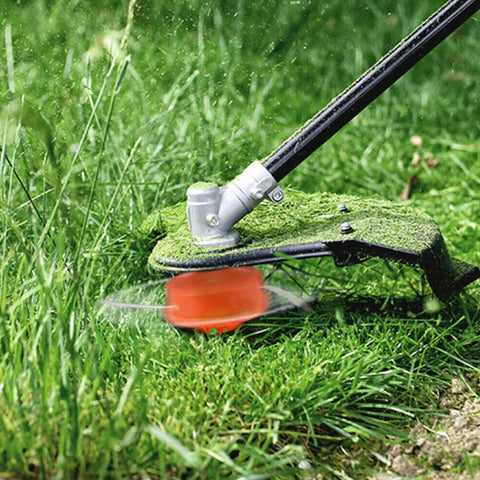When it comes to maintaining your lawn or garden, a whipper snipper is an invaluable tool, known for its efficiency and versatility. But have you ever wondered how this dynamic tool works its magic? Understanding the mechanics behind a whipper snipper not only satisfies curiosity but also empowers you with knowledge that can enhance your usage, ensuring both effectiveness and safety.
In this article, we delve into the world of whipper snippers, unraveling the technical wizardry that allows these tools to trim and shape your outdoor spaces with precision. From the power hidden within its engine to the rapid spinning of the cutting head and the science of centrifugal force, we'll explore each component that contributes to the whipper snipper’s impressive performance.
So, let's gear up and discover what makes whipper snippers tick, enhancing your gardening experience one cut at a time.
Engine Power

The engine is the powerhouse of a whipper snipper, responsible for bringing all its components to life. In this section, we will explore the types of engines used in whipper snippers and how they contribute to the tool's overall performance.
1. Types of Engines
- Gasoline Engines: These are the traditional choice for whipper snippers. They are known for their robust power and durability, making them suitable for heavy-duty tasks. We'll discuss the benefits of gasoline engines, such as their longer runtime and ability to handle thicker vegetation.
- Electric Engines: Growing in popularity, electric engines offer a quieter, more environmentally friendly alternative. They are ideal for smaller yards or residential areas where noise may be a concern. Here, we'll explore the advantages of electric models, including their ease of maintenance and lightweight design.
2. Engine Maintenance
- Gasoline Engine Maintenance: Regular maintenance is crucial to keep a gasoline engine running smoothly. We'll cover essential maintenance tasks such as changing the oil, cleaning or replacing air filters, and checking the spark plug. Additionally, we'll provide tips on proper fuel storage and handling.
- Electric Engine Maintenance: Electric engines require less maintenance than their gasoline counterparts. We'll guide you through basic care steps like battery care, cleaning the motor area, and ensuring proper storage to prolong battery life.
The Cutting Head

The cutting head is where the whipper snipper's true functionality comes to life. It's the part that directly interacts with grass and weeds, providing the actual cutting action. In this section, we will delve into the design of the cutting head, the role of the nylon line, and how to maintain and replace it for optimal performance.
1. Design and Material
The cutting head of a whipper snipper is ingeniously designed to be both robust and efficient. Typically made from high-grade composites or metals, it's built to withstand high-speed rotation and the wear and tear of cutting through tough vegetation. At its core lies the nylon line – a marvel of engineering. Chosen for its remarkable blend of strength, flexibility, and durability, the nylon line can slice through grass and weeds with ease, yet it's gentle enough not to damage hard surfaces like fences or garden edges.
The thickness of the nylon line is a key factor in its cutting ability. Thicker lines can handle tougher, more dense vegetation, but they require more power to spin. Conversely, thinner lines are suited for lighter trimming tasks and are generally used in less powerful whipper snippers.
2. Line Replacement
Knowing when and how to replace the nylon line is essential for maintaining the effectiveness of your whipper snipper.
Signs It's Time to Replace the Line:
- Frequent line breakage, indicating wear.
- Visible fraying or thinning of the line.
- Decreased cutting efficiency, requiring more passes to trim the same area.
Step-by-Step Replacement Guide:
- Safety First: Ensure the whipper snipper is turned off and disconnected from its power source.
- Remove the Cutting Head Cap: Carefully unscrew or unclip the cap covering the spool that holds the line.
- Take Out the Old Line: Unwind any remaining old line from the spool and dispose of it properly.
- Measure and Cut New Line: Measure the recommended length of new nylon line (usually indicated in the user manual) and cut it.
- Thread the Line: Carefully thread the line into the spool, following the arrows or guides. Ensure it's wound tightly and evenly.
- Reattach the Cap: Once the line is securely in place, reattach the cap to the cutting head.
Troubleshooting:
- If the line is not feeding properly, check for any obstructions in the spool or incorrect winding.
- Ensure the line is the correct thickness for your model.
Centrifugal Force in Action
Centrifugal force is the unseen hero of a whipper snipper's functionality. This section explains how this force works and the safety considerations that come with it.
1. Physics Behind the Force
Centrifugal force arises from the rapid spinning motion of the whipper snipper's cutting head. As the head rotates, the force causes the nylon line to extend outward, stiffening it enough to cut through grass and weeds effectively. The faster the head spins, the stronger the force, which directly influences the cutting capability. This principle allows the whipper snipper to tackle various vegetation types, from light grass to denser weeds.
2. Safety Considerations
Proper handling and safety are paramount when dealing with the powerful forces at play in a whipper snipper.
Handling the Force:
- Maintain a firm grip on the whipper snipper, keeping your stance balanced and stable.
- Move smoothly and steadily, allowing the force of the spinning line to do the work.
Safety Gear:
- Always wear protective gear, including goggles to protect your eyes from flying debris, gloves for better grip and hand protection, and long pants to shield your legs.
- Ear protection is also recommended, especially for prolonged use or with louder, gasoline-powered models.
Awareness of Surroundings:
- Be conscious of where the tool is in relation to objects and people. The spinning line can pick up and propel small objects at high speeds.
- Clear the area of stones, toys, and other debris before starting.
The Cutting Action

The cutting action of a whipper snipper is where the device truly showcases its efficiency. This section will delve into how the whipper snipper cuts through grass and weeds, and how its design maximizes cutting efficiency.
1. How It Cuts
The whipper snipper utilizes the high velocity of its spinning nylon line to cut through vegetation. As the engine powers the cutting head, the nylon line, extended by centrifugal force, rotates at a high speed. This speed is crucial – it's what allows the relatively soft nylon to slice through grass and weeds effectively.
The cutting action can be likened to that of a high-speed, flexible serrated blade. As the line whips through the vegetation, it makes quick, clean cuts, similar to how a chef's knife slices through ingredients. The efficiency of this cutting action depends on several factors:
- Line Speed: Faster rotation results in more effective cutting.
- Line Thickness: Thicker lines can handle tougher vegetation but require more power.
- Cutting Technique: Proper technique, such as the angle of approach and movement speed, enhances the cutting effectiveness.
2. Efficiency and Speed
The efficiency and speed of a whipper snipper make it a preferred tool for garden maintenance. Here are some factors that contribute to its efficiency:
- Line Material: Modern nylon lines are engineered for maximum durability and cutting efficiency.
- Engine Power: Higher-powered engines can spin the line faster, resulting in quicker, more effective cutting.
- Ergonomic Design: Many whipper snippers are designed for ease of use, allowing for faster movement and less user fatigue.
The cutting action of a whipper snipper is a blend of engineering and physics, creating a tool that's both powerful and precise. Understanding this can help users make the most of their whipper snipper, ensuring efficient and effective garden maintenance.
Adjustable Height and Precision Trimming
The adjustable height feature of a whipper snipper plays a crucial role in its versatility and precision. This section explores how users can leverage this feature for optimal trimming results, whether edging along sidewalks or maintaining uniform lawn height.
1. Adjusting the Height
Adjusting the cutting height of a whipper snipper is essential for achieving the desired outcome in various trimming tasks. Here's how users can adjust the height for different needs:
- Understanding the Adjustment Mechanism: Most whipper snippers come with an adjustable head or shaft that allows the user to change the height. This could involve turning a knob, adjusting a lever, or repositioning the head.
- Step-by-Step Adjustment Process: Provide a simple guide on how to adjust the height. This may vary slightly depending on the model, so referencing the user manual is advisable.
- Safety Precautions: Remind users to ensure the tool is turned off and disconnected from the power source before making any adjustments.
2. Applications for Different Heights
Different trimming tasks require different height settings. Here, we'll discuss various scenarios and the ideal height settings for each:
- Lawn Trimming: For a uniform lawn height, a medium setting is typically best. This allows for effective cutting without scalping the grass too close to the root.
- Edging Along Sidewalks and Driveways: A lower setting can provide a cleaner edge along hard surfaces, giving a neat, manicured look.
- Trimming Around Flowerbeds and Trees: A higher setting might be preferable around delicate areas to avoid damaging plants or tree bark.
- Tackling Tough Weeds or Overgrown Areas: A robust, medium-to-high setting can help manage more challenging vegetation without putting too much strain on the motor.
Conclusion
From understanding the core principles of its engine and cutting head to harnessing the power of centrifugal force for precision cutting, each aspect of this versatile tool has been unveiled. We've journeyed through the intricacies of its operation, the subtleties of its adjustable features, and the essentials of its maintenance and care.
Remember, your whipper snipper is more than just a piece of equipment; it's a partner in your gardening endeavors. By embracing the knowledge of how it works and committing to its upkeep, you ensure that every trimming task is not just a chore, but an opportunity to craft and shape your outdoor space with skill and ease.
As you contemplate the right whipper snipper for your needs, take a moment to browse through our diverse collection, designed for every gardener. May every start of its engine be a reminder of the power and precision at your fingertips, and every clean cut a testament to the care and knowledge you've invested in your tool.
Here's to many seasons of successful and satisfying gardening, with your whipper snipper as a trusty and efficient ally.

